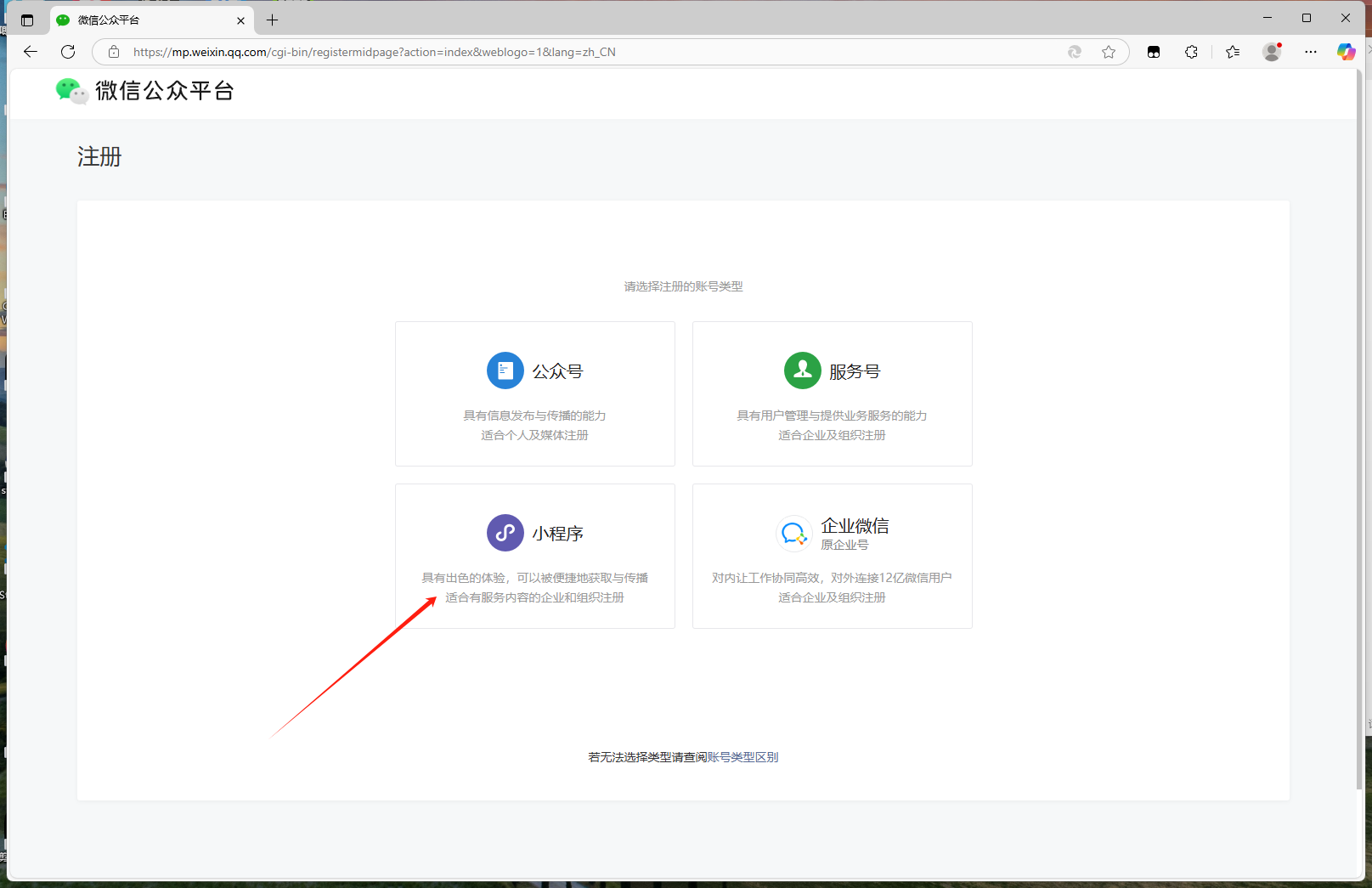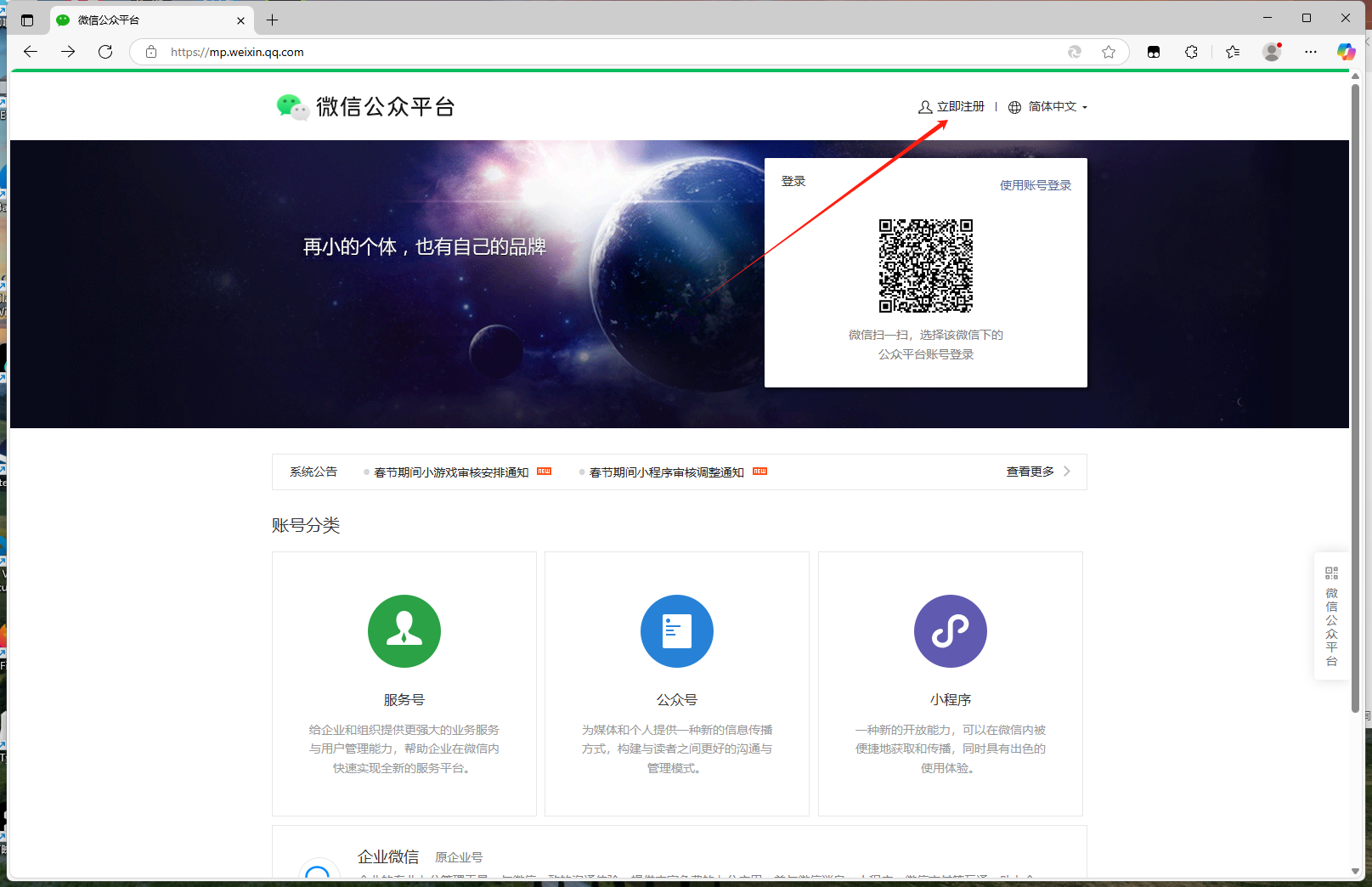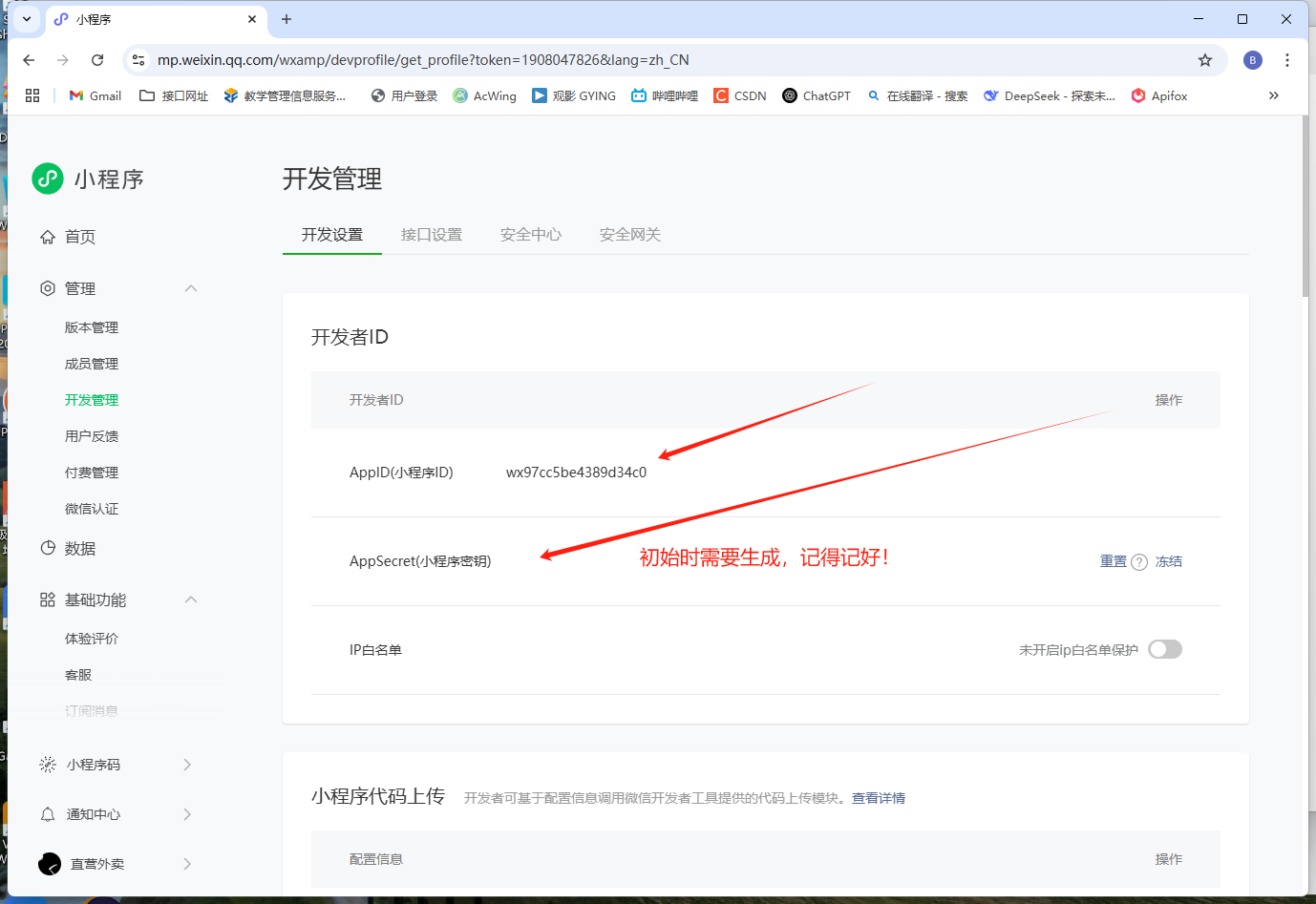SpringBoot后端实现小程序微信登录_springboot 微信小程序登录
目录
SpringBoot实现微信小程序登录简介
SpringBoot后端实现微信登录
注册小程序,获取key
SpringBoot实现微信小程序登录简介
微信小程序登录是开发者通过微信提供的身份验证机制,获取用户唯一标识(openid)和会话密钥(session_key)的过程。SpringBoot作为后端框架,可以与小程序前端配合完成完整的登录流程。
-
小程序端调用wx.login()
-
小程序前端调用此API获取临时登录凭证code
-
示例代码:
wx.login({ success(res) { if (res.code) { // 发送code到后端 } }})
-
-
SpringBoot后端处理登录
-
接收小程序传来的code
-
向微信接口服务发起请求验证code
-
获取用户唯一标识openid和会话密钥session_key
-
-
返回自定义登录态
-
后端生成自定义登录态(如token)并返回给小程序
-
小程序后续请求携带此登录态
-
SpringBoot后端实现微信登录
1.导入HttpClient的Maven坐标
org.apache.httpcomponents httpclient 4.5.132.Http工具类
/** * Http工具类 */public class HttpClientUtil { static final int TIMEOUT_MSEC = 5 * 1000; /** * 发送GET方式请求 * @param url * @param paramMap * @return */ public static String doGet(String url,Map paramMap){ // 创建Httpclient对象 CloseableHttpClient httpClient = HttpClients.createDefault(); String result = \"\"; CloseableHttpResponse response = null; try{ URIBuilder builder = new URIBuilder(url); if(paramMap != null){ for (String key : paramMap.keySet()) { builder.addParameter(key,paramMap.get(key)); } } URI uri = builder.build(); //创建GET请求 HttpGet httpGet = new HttpGet(uri); //发送请求 response = httpClient.execute(httpGet); //判断响应状态 if(response.getStatusLine().getStatusCode() == 200){ result = EntityUtils.toString(response.getEntity(),\"UTF-8\"); } }catch (Exception e){ e.printStackTrace(); }finally { try { response.close(); httpClient.close(); } catch (IOException e) { e.printStackTrace(); } } return result; } /** * 发送POST方式请求 * @param url * @param paramMap * @return * @throws IOException */ public static String doPost(String url, Map paramMap) throws IOException { // 创建Httpclient对象 CloseableHttpClient httpClient = HttpClients.createDefault(); CloseableHttpResponse response = null; String resultString = \"\"; try { // 创建Http Post请求 HttpPost httpPost = new HttpPost(url); // 创建参数列表 if (paramMap != null) { List paramList = new ArrayList(); for (Map.Entry param : paramMap.entrySet()) { paramList.add(new BasicNameValuePair(param.getKey(), param.getValue())); } // 模拟表单 UrlEncodedFormEntity entity = new UrlEncodedFormEntity(paramList); httpPost.setEntity(entity); } httpPost.setConfig(builderRequestConfig()); // 执行http请求 response = httpClient.execute(httpPost); resultString = EntityUtils.toString(response.getEntity(), \"UTF-8\"); } catch (Exception e) { throw e; } finally { try { response.close(); } catch (IOException e) { e.printStackTrace(); } } return resultString; } /** * 发送POST方式请求 * @param url * @param paramMap * @return * @throws IOException */ public static String doPost4Json(String url, Map paramMap) throws IOException { // 创建Httpclient对象 CloseableHttpClient httpClient = HttpClients.createDefault(); CloseableHttpResponse response = null; String resultString = \"\"; try { // 创建Http Post请求 HttpPost httpPost = new HttpPost(url); if (paramMap != null) { //构造json格式数据 JSONObject jsonObject = new JSONObject(); for (Map.Entry param : paramMap.entrySet()) { jsonObject.put(param.getKey(),param.getValue()); } StringEntity entity = new StringEntity(jsonObject.toString(),\"utf-8\"); //设置请求编码 entity.setContentEncoding(\"utf-8\"); //设置数据类型 entity.setContentType(\"application/json\"); httpPost.setEntity(entity); } httpPost.setConfig(builderRequestConfig()); // 执行http请求 response = httpClient.execute(httpPost); resultString = EntityUtils.toString(response.getEntity(), \"UTF-8\"); } catch (Exception e) { throw e; } finally { try { response.close(); } catch (IOException e) { e.printStackTrace(); } } return resultString; } private static RequestConfig builderRequestConfig() { return RequestConfig.custom() .setConnectTimeout(TIMEOUT_MSEC) .setConnectionRequestTimeout(TIMEOUT_MSEC) .setSocketTimeout(TIMEOUT_MSEC).build(); }}3.JWT工具类
import io.jsonwebtoken.Claims;import io.jsonwebtoken.JwtBuilder;import io.jsonwebtoken.Jwts;import io.jsonwebtoken.SignatureAlgorithm;import java.nio.charset.StandardCharsets;import java.util.Date;import java.util.Map;public class JwtUtil { /** * 生成jwt * 使用Hs256算法, 私匙使用固定秘钥 * * @param secretKey jwt秘钥 * @param ttlMillis jwt过期时间(毫秒) * @param claims 设置的信息 * @return */ public static String createJWT(String secretKey, long ttlMillis, Map claims) { // 指定签名的时候使用的签名算法,也就是header那部分 SignatureAlgorithm signatureAlgorithm = SignatureAlgorithm.HS256; // 生成JWT的时间 long expMillis = System.currentTimeMillis() + ttlMillis; Date exp = new Date(expMillis); // 设置jwt的body JwtBuilder builder = Jwts.builder() // 如果有私有声明,一定要先设置这个自己创建的私有的声明,这个是给builder的claim赋值,一旦写在标准的声明赋值之后,就是覆盖了那些标准的声明的 .setClaims(claims) // 设置签名使用的签名算法和签名使用的秘钥 .signWith(signatureAlgorithm, secretKey.getBytes(StandardCharsets.UTF_8)) // 设置过期时间 .setExpiration(exp); return builder.compact(); } /** * Token解密 * * @param secretKey jwt秘钥 此秘钥一定要保留好在服务端, 不能暴露出去, 否则sign就可以被伪造, 如果对接多个客户端建议改造成多个 * @param token 加密后的token * @return */ public static Claims parseJWT(String secretKey, String token) { // 得到DefaultJwtParser Claims claims = Jwts.parser() // 设置签名的秘钥 .setSigningKey(secretKey.getBytes(StandardCharsets.UTF_8)) // 设置需要解析的jwt .parseClaimsJws(token).getBody(); return claims; }}4.准备好签名所需使用的密钥,过期时间等
sky: jwt: user-secret-key: itcast # 设置jwt过期时间 user-ttl: 7200000 # 设置前端传递过来的令牌名称 user-token-name: authentication5.用对象类将配置文件的属性封装
@Component@ConfigurationProperties(prefix = \"sky.jwt\")@Datapublic class JwtProperties { /** * 用户端微信用户生成jwt令牌相关配置 */ private String userSecretKey; private long userTtl; private String userTokenName;}6.WeChatProperties对象类部分属性以及配置文件
关于怎么注册大家可以移步最下方。
@Component@ConfigurationProperties(prefix = \"sky.wechat\")@Datapublic class WeChatProperties { private String appid; //小程序的appid private String secret; //小程序的秘钥}//application.yml配置文件sky: wechat: appid: ${sky.wechat.appid} secret: ${sky.wechat.secret}//application-dev.yml配置文件sky: wechat:# TODO:需要在微信公众平台申请相关信息并填入 appid: ****** secret: ******7.准备好DTO数据对象
/** * C端用户登录 */@Datapublic class UserLoginDTO implements Serializable { private String code;}8.控制层接口
@RestController@RequestMapping(\"/user/user\")@Slf4j@RequiredArgsConstructor // Lombok 自动生成构造函数@Api(tags = \"C端用户相关接口\")public class UserController { private final UserService userService; private final JwtProperties jwtProperties; /** * 微信登录 * @param userLoginDTO * @return */ @PostMapping(\"/login\") @ApiOperation(\"微信登录\") public Result login(@RequestBody UserLoginDTO userLoginDTO){ log.info(\"微信用户登录:{}\",userLoginDTO.getCode()); //微信登录 User user = userService.wxLogin(userLoginDTO); //为微信用户生成jwt令牌 Map claims = new HashMap(); claims.put(JwtClaimsConstant.USER_ID,user.getId()); String token = JwtUtil.createJWT(jwtProperties.getUserSecretKey(),jwtProperties.getUserTtl(),claims); UserLoginVO userLoginVO = UserLoginVO.builder() .id(user.getId()) .openid(user.getOpenid()) .token(token) .build(); return Result.success(userLoginVO); }}9.微信登录的服务层的接口和实现类
//接口public interface UserService { /** * 微信登录接口 * @param userLoginDTO * @return */ User wxLogin(UserLoginDTO userLoginDTO);}//实现类@Service@Slf4jpublic class UserServiceImpl implements UserService { public static final String WX_LOGIN = \"https://api.weixin.qq.com/sns/jscode2session\"; @Autowired private WeChatProperties weChatProperties; @Autowired private UserMapper userMapper; /** * 微信登录 * @param userLoginDTO * @return */ @Override public User wxLogin(UserLoginDTO userLoginDTO) { String openid = getOpenid(userLoginDTO.getCode()); //判断openid是否为空,如果为空表示登录失败,抛出业务异常 if(openid == null){ throw new LoginFailedException(MessageConstant.LOGIN_FAILED); } //判断当前用户是否是新用户 User user = userMapper.getByOpenid(openid); //如果是新用户,自动完成注册 if(user == null){ user = User.builder() .openid(openid) .createTime(LocalDateTime.now()) .build(); userMapper.insert(user); } //返回这个用户对象 return user; } /** * 调用微信接口服务,获取当前微信用户的openid * @param code * @return */ private String getOpenid(String code){ Map map = new HashMap(); map.put(\"appid\",weChatProperties.getAppid()); map.put(\"secret\",weChatProperties.getSecret()); map.put(\"js_code\",code); map.put(\"grant_type\",\"authorization_code\"); String json = HttpClientUtil.doGet(WX_LOGIN, map); JSONObject jsonObject =JSON.parseObject(json); String openid = jsonObject.getString(\"openid\"); return openid; }}注册小程序,获取key
微信公众平台



本篇文章到这里就要结束了,觉得有用的话,还请点个发财的小赞!谢谢啦


